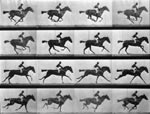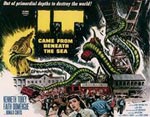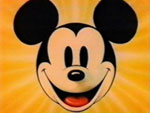Styles and Techniques
So where do we start with such a huge subject? The MOVE IT animation tutorial is focused on a traditional method of hand drawn animation but many of the basics you’ll learn throughout the tutorial can be related to other methods of animation.
A Brief History Lesson...
The early days of animation involved drawing individual frames directly onto glass plates and then filming each frame one at a time. The process advanced and led to the replacement of glass plates with celluloid sheets or cels. These were flexible and easier to work with, making the process of drawing, inking and painting frames of animation a little easier.
 Eadweard Muybridge pioneered photographic techniques back in the 1800's that used multiple still cameras to create photographic sequences.
Eadweard Muybridge pioneered photographic techniques back in the 1800's that used multiple still cameras to create photographic sequences.
These images could then be viewed using a device called a zoopraxiscope, considered a forerunner to the movie projector, this device allowed an audience to see very simple moving sequences.
 Ray Harryhausen is famously remembered for his stop-motion model animation techniques in movie classics such as 'Jason and the Argonauts', 'One Million Years B.C.', 'Clash of the Titans' and many more.
Ray Harryhausen is famously remembered for his stop-motion model animation techniques in movie classics such as 'Jason and the Argonauts', 'One Million Years B.C.', 'Clash of the Titans' and many more.
Although his work may look crude by modern standards his techniques still continue to inspire many of today's great animators and movie makers.
 It's hard to think about Traditional hand-drawn animation without the name 'Disney' coming to mind. Walt Disney is famous for his creation of 'Mickey Mouse' (and, of course, his theme parks!). Walt Disney's studios have created 44 traditional animations since 1938, as well as a considerable number of live-action films.
It's hard to think about Traditional hand-drawn animation without the name 'Disney' coming to mind. Walt Disney is famous for his creation of 'Mickey Mouse' (and, of course, his theme parks!). Walt Disney's studios have created 44 traditional animations since 1938, as well as a considerable number of live-action films.
Although Disney's contribution to animation cannot be denied, it is also the case that there have been many other great contributors and influences over the years. Historically animators have looked to regions such as Central Europe, Eastern Europe and Russia for such inspiration. Individuals such as Raoul Servais from Belgium, Jan Svankmajer from Czechoslovakia and Alexandre Petrov from Russia are regarded as giants by fellow animators and continue to influence animators the world over. Jan Svankmajer for instance is hardly known in the mainstream and yet his work is known to have influenced the makers of Toy Story. Take a look at these examples of Jan's work on the Animation World Network website and think of Sid's gruesome toy collection and you'll recognise the influence.

 Computer generated 3D animation has gained popularity since it was first used in the feature film 'Futureworld' in 1976. One of the main advantages the 3D process of animation offers is speed, as a lot of the intensive work of creating the individual frames can be generated automatically by computer.
Computer generated 3D animation has gained popularity since it was first used in the feature film 'Futureworld' in 1976. One of the main advantages the 3D process of animation offers is speed, as a lot of the intensive work of creating the individual frames can be generated automatically by computer.
The process had matured by 1982 when Disney released 'Tron' featuring 30 minutes of 3D animation, the movie is heralded as a milestone of computer animation. The first completely computer generated feature film was Pixar's 1995 box office hit 'Toy Story', which opened the doors to a new era of mainstream animated feature film.
In recent times the computer and video games industry has become a major employer of animators. Today's hyper-realistic computer games are often on a similar scale to Hollywood productions and require teams with diverse talents. Animators have the skills to design and develop characters and storyboards as well as to appreciate the importance of script development. They also understand anatomy and can advise on character movement, camera direction and lighting.
Popular Styles and Techniques: